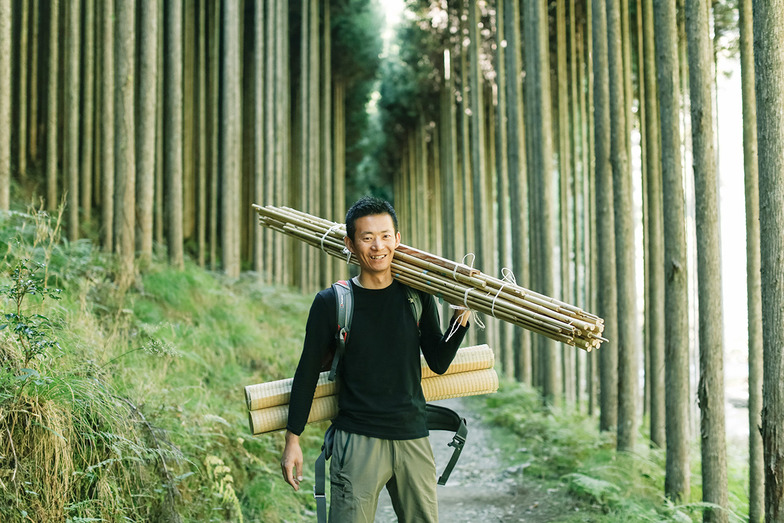"Behind the Scenes of 'Expressions That Resonate'" focuses on "successful promoters of expressive activities" across various fields. This time, we spoke with Mr. Toda, who serves tea in "Kian" – a tea room constructed solely from bamboo, unconstrained by conventional tea room concepts – about the rich world born from this space.
It's a tea room called "Kian," built solely from a bamboo frame. I started this activity about two years ago, assembling it in various locations to host tea ceremonies. While I've always enjoyed the outdoors, I wanted to re-examine the importance of "waiting" in our efficiency-driven modern world. For instance, even when standing atop a mountain, our minds often immediately turn to the next step: the descent. Driven by a desire to savor "the moment" more deeply, I thought, "At the very least, let's wait for the water to boil, prepare tea, and drink it."
The tea room's form has been stripped down, stripped down, to the utmost simplicity. After repeated refinements, the current version weighs a total of 5.5 kilograms. You can bundle the parts and carry them on your back alone. It's small enough to carry onto a plane, so you can take it overseas too. So far, I've held tea gatherings in various environments: riversides, seashores, plazas, mountains, indoors, day and night. Even in stormy weather, we wear rain gear and proceed. The basic approach is to drive to an accessible area, then carry the components a short distance on foot to assemble the tea room. My dream is to one day complete a tour of Japan's "100 Famous Waters" alongside my tea house. I want to draw water from each location, enjoy local Japanese sweets, and share tea together.
Our tea gatherings vary: sometimes among friends, sometimes open to participants, sometimes spontaneously inviting passersby. We simply remove our shoes to enter this tea room, eat sweets, and drink tea. Just that simple act. Yet, somehow, it brings a sense of fulfillment beyond words. As we slowly sip the tea, the restlessness in our hearts gradually quiets. Then, the sounds of the surrounding nature become distinctly clear. Communication with the scenery before us, the guests beside us, and myself as the host becomes strangely effortless. Some guests are so moved they leave the tea room in tears.
This past July, I brought this Kikan tea house to Kumamoto, which had been devastated by an earthquake. We held a charity tea gathering at a spot overlooking the damaged Kumamoto Castle keep. We prayed for the castle's restoration and shared conversations with many people. Local residents told me, "We hadn't realized this was a way to support reconstruction." I believe sharing tea and exchanging thoughts surely helped calm their spirits.

Kyoto, Takao - Kiyotaki Riverbed
Kyoto has long preserved its tea culture, and I believe its origin lies in the calming effect communication brings to the heart. The various tea ceremony protocols exist to ensure everyone feels comfortable and the entire flow proceeds smoothly. Within the stage of the tea room, both host and guest act as performers. This gives rise to a state of mind absent from everyday life.
The concept of "mountain retreat in the city" exists within tea culture. It represents the desire to incorporate a connection with nature even while living in the city. Kyoto has many tea rooms with beautiful gardens, but from the perspective of someone living in a temple, a garden is essentially a 100% artificial, natural-looking structure. A garden is something humans meticulously create, incorporate into their dwelling, and maintain. The idea behind Kikan is a slight reversal of this concept: bringing the tea room into the natural environment.
The beauty of Kian lies in its minimalism and incompleteness as a tea room. And because it's taken outdoors, there's no need for expensive utensils. These elements conversely become engines that spark the guest's imagination. Kian is a tea room completed by imagination. Literally a tea room with a low threshold, it serves as an accessible example of simple tea culture, welcoming foreigners and young people interested in Japanese culture even without detailed knowledge. I believe such new forms can serve as one gateway for those wishing to engage with Japanese culture.

Mr. Masayuki Inada of Yamanaka Komuten, who designed and built Kian






